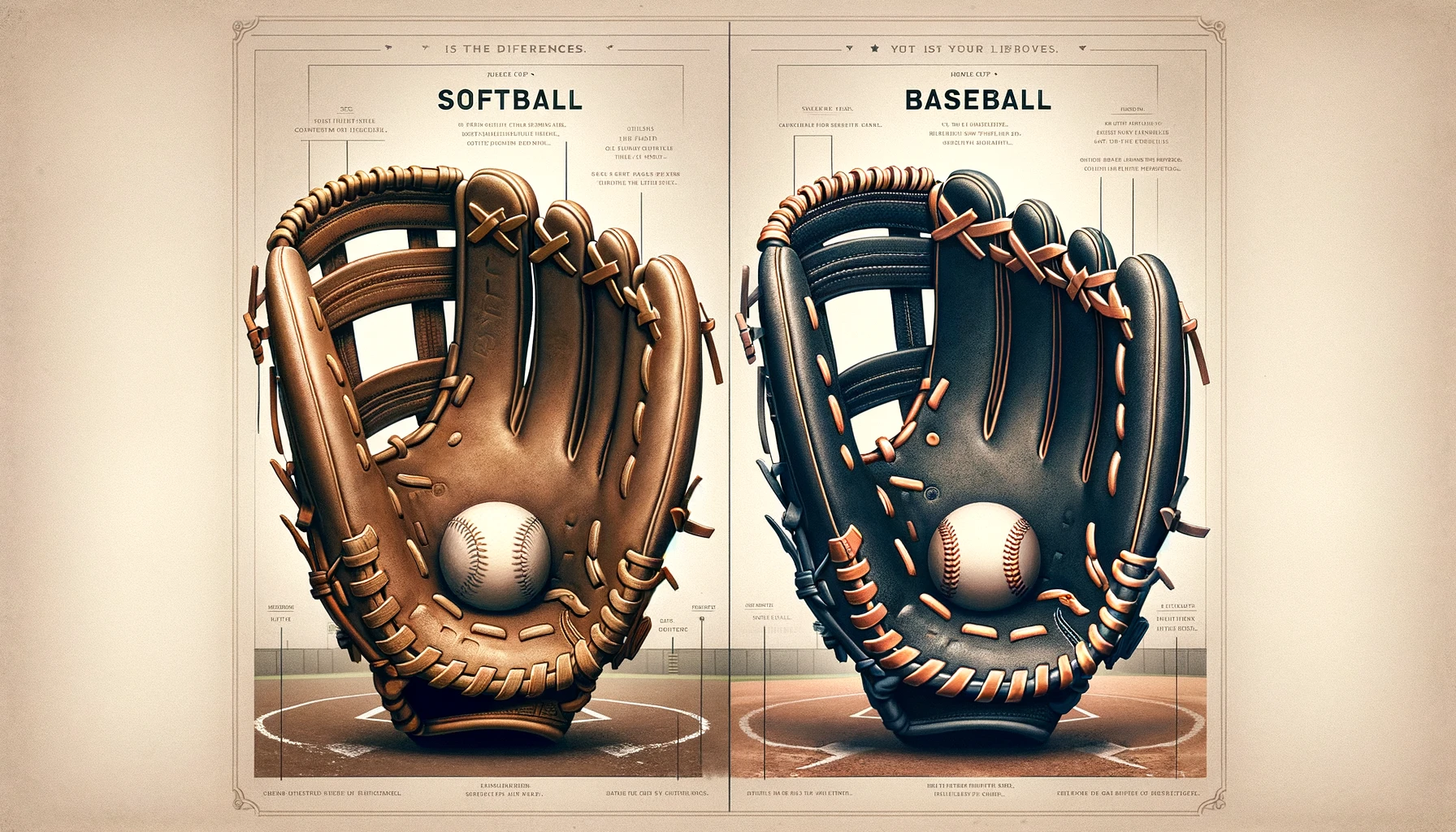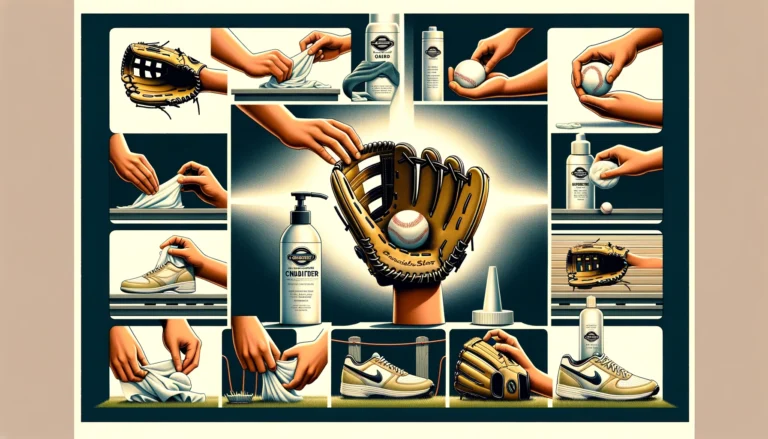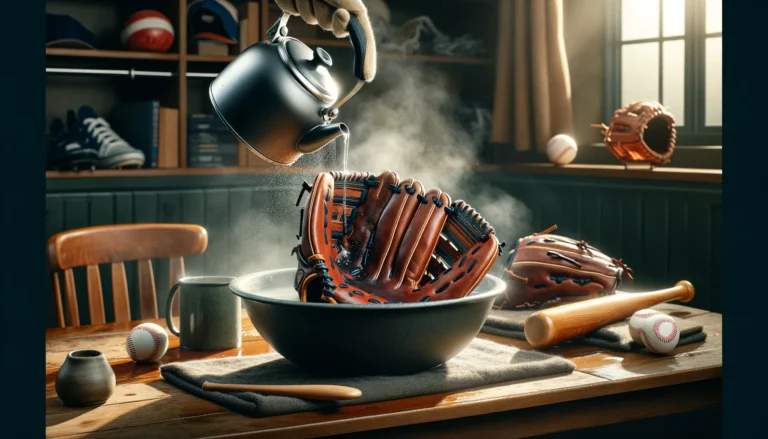Is There a Difference Between Softball and Baseball Gloves?
Choosing the right glove is crucial for any baseball or softball player. But with so many options on the market, it can be confusing to know which glove is best suited for your game.
Using the wrong glove can not only hinder your performance but also increase your risk of injury. A baseball glove that’s too stiff or a softball glove that’s too flexible could cause you to misplay catches or experience excessive hand fatigue.
Understanding the key differences between softball and baseball gloves is essential for finding the perfect fit for your needs.
In this article, we’ll explore the distinct features, materials, and designs that set these gloves apart, so you can make an informed decision and elevate your game.
The Great Glove Breakdown: Baseball vs. Softball

Size Matters: Comparing Glove Dimensions
When it comes to the world of ball gloves, size is a defining factor that separates baseball and softball equipment.
Baseball gloves are typically smaller, designed to fit the more compact baseball, allowing for a snugger fit and greater control.
This precise fit is crucial for players, especially the younger ones, as it aids in gripping and maneuvering the ball with ease.
In contrast, softball gloves are tailored to accommodate the larger softball. This results in a generally larger glove size, with a deeper pocket to securely cradle the ball.
The difference in pocket depth is significant; while a baseball glove has a shallower pocket to facilitate quick ball retrieval and throwing, a softball glove’s pocket is designed to provide an extra ‘hug’ to prevent the ball from popping out.
Here’s a quick comparison of typical glove sizes by position:
| Position | Baseball Glove Size | Softball Glove Size |
|---|---|---|
| Infield | 10.5″ – 11.5″ | 11.5″ – 12.5″ |
| Outfield | 12″ – 12.75″ | 12.5″ – 14″ |
| Catcher | 32.5″ – 34″ | 33″ – 35″ |
| First Base | 12″ – 13″ | 12.5″ – 13″ |
| Pitcher | 11.5″ – 12″ | 11.5″ – 12.5″ |
Understanding these differences is essential for players at any level, but it becomes increasingly important as they advance and play more competitively.
The right glove not only fits a baseball catcher’s mitt well but also complements the player’s style and position on the field.
Pocket Depth Perception: Baseball vs. Softball
The design of a glove’s pocket plays a pivotal role in how a player catches and secures the ball. In baseball, gloves tend to have a shallower pocket to allow for quick ball transfer, essential for fast-paced plays.
Softball gloves, on the other hand, feature a deeper pocket to accommodate the larger ball size and to enhance grip during catches.
While both sports require gloves that aid in performance, the differences in pocket depth are a direct response to the unique demands of each game.
Softball and baseball differ in field size, pitching style, ball size, and equipment.
Baseball is generally considered more challenging, but both sports demand skill and precision in unique ways.
| Feature | Baseball Glove | Softball Glove |
|---|---|---|
| Pocket Depth | Shallow | Deep |
| Ball Transfer | Quick | Moderate |
| Ball Size | Smaller | Larger |
Selecting the right glove with the appropriate pocket depth can significantly impact a player’s ability to perform on the field. It’s not just about the fit; it’s about how the glove complements the player’s style and the sport’s requirements.
Design Specifics: Tailoring to the Sport
When it comes to softball and baseball gloves, the design is tailored to meet the specific demands of each sport.
Baseball gloves are typically designed with a shallower pocket to allow for quick ball retrieval and transfer. In contrast, softball gloves have a deeper pocket to accommodate the larger ball size.
The construction of the glove also varies between the two sports. For instance, a youth pro taper fit might be more common in baseball gloves, which provide a snugger fit for smaller hands.
Softball gloves, on the other hand, might feature a basket web design that offers a flexible yet secure catch.
Here’s a quick comparison of some common design features:
- Baseball Gloves:
- Shallow pocket for quick ball transfer
- Youth Pro Taper Fit for Smaller Hands
- Cushioned finger linings for comfort
- Softball Gloves:
- A deeper pocket for a larger ball
- Basket Web design for secure catch
- Sure Catch Heel Cutout Design for easier closure
Choosing the right glove design can significantly impact a player’s performance on the field. It’s essential to consider these differences when selecting a glove, as they can enhance playability and confidence during the game.
Read Also: What is the Glove Runners Wear in Baseball
Webbing Wonders: A Quick Peek at Glove Design
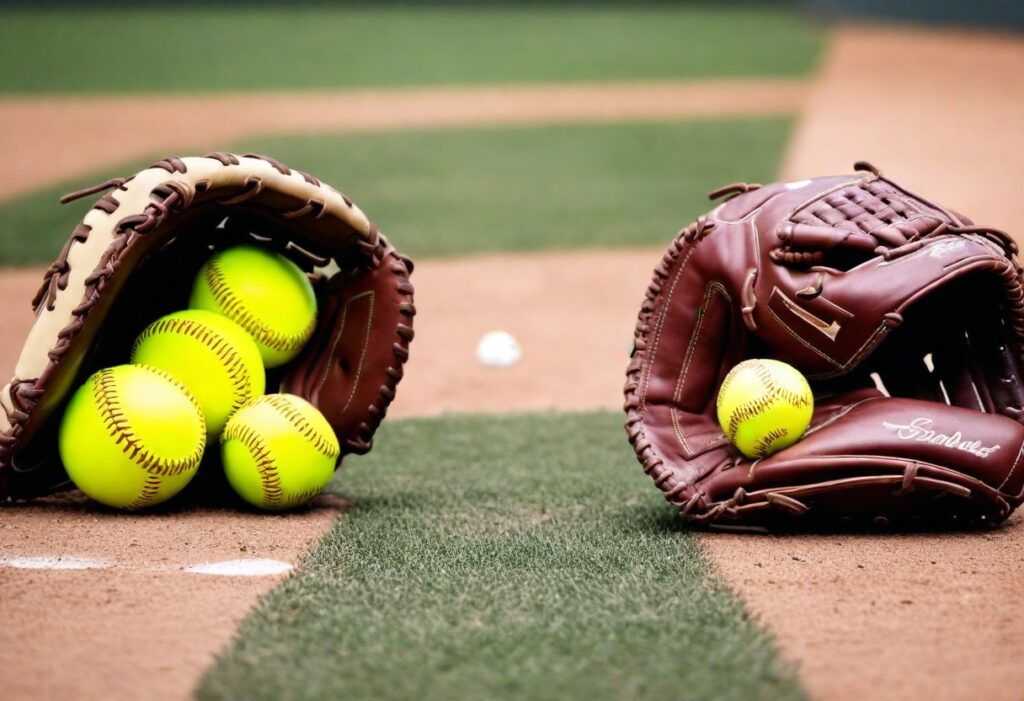
The Webbing Workings: Structure and Function
The webbing of a glove is a critical feature that often goes unnoticed, yet it plays a pivotal role in a player’s performance.
Webbing is the woven part that connects the thumb to the rest of the fingers, forming a net-like structure that is essential for catching the ball.
It’s akin to the sunroof of a car, where some prefer it sealed and others with a view; the choice of webbing is highly personal and tailored to the player’s position and needs.
Open webbing is characterized by its loose cross patterns, which offer increased visibility and flexibility.
This design is particularly beneficial for fielders who require quick ball transfers of balls from glove to hand.
Closed webbing, conversely, provides a more solid and consistent catching surface, often favored by pitchers who value discretion over visibility.
When selecting a glove, the webbing style should resonate with your playing style and position.
Remember, it’s not just about the glove fitting well; it’s about how the webbing complements your game. Here’s a quick overview of a common webbing type:
- Basket Web
- Youth Pro Taper Fit
- All Leather Shell Construction
- Cushioned Finger Linings
- Sure Catch Heel Cutout Design
Material Choices: Leather Grades and Their Impact
The leather used in glove construction is not just a matter of aesthetics; it’s a critical component that defines the glove’s feel, durability, and performance.
The grade of leather is directly proportional to the glove’s longevity and comfort. Higher-grade leathers, such as full-grain or top-grain, are sturdier and conform to the player’s hand over time, offering a custom fit.
Conversely, synthetic leathers or lower-grade hides may be less expensive but often compromise on feel and durability.
Here’s a quick rundown of common leather grades used in gloves:
- Full-Grain Leather: Retains the entire grain layer, robust and durable.
- Top-Grain Leather: Thinner than full-grain, it’s flexible with a break-in period.
- Kip Leather: Lightweight and preferred by professional players for its quick break-in.
- Steerhide: Tough and heavy, requiring more break-in time but very durable.
- Cowhide: A balance between durability and ease of break-in, a popular choice for youth.
- Synthetic Leather: Offers a lightweight option with minimal break-in, ideal for younger players.
Selecting the right leather grade is a balance between immediate comfort and the anticipated level of play.
A well-chosen glove becomes an extension of the player’s hand, enhancing their connection to the game.
Stitching and Durability: What to Look For
When selecting a baseball or softball glove, the stitching is a critical factor that contributes to the glove’s overall durability and lifespan.
Look for tight, uniform stitching that indicates quality craftsmanship. This will ensure that your glove can withstand the rigors of the game over multiple seasons.
The type of stitch used can also affect the glove’s performance. For example, double or triple stitching offers added strength, especially in high-stress areas like the webbing and pocket.
Below is a list of key stitching features to consider:
- Double or Triple Stitching: Reinforces the glove’s structure.
- Uniform Stitching: Indicates careful construction.
- High-Quality Thread: Resists wear and tear.
- Reinforced Palm Area: Provides extra support.
Remember, a well-stitched glove not only lasts longer but also maintains its shape better, which is crucial for consistent play.
If you’re unsure about the stitching quality, don’t hesitate to seek advice from a coach or a seasoned player.
They can provide insights on what has worked well for them, much like Baseball Prosper’s detailed insights on various aspects of the game.
Read Also: What Hand Do You Wear a Baseball Glove On
Securing Success: Finding the Perfect Glove

Fit and Comfort: Ensuring the Right Match
Finding the perfect glove is crucial for both comfort and performance on the field. A glove that fits well is essential for optimal catching and fielding.
It should feel like an extension of your hand, snug but not constricting, allowing for flexibility and control.
Here are some tips to ensure you get the right fit:
- Measure your hand: Use a tape measure or a sizing chart to determine the appropriate glove size.
- Try on different styles: Gloves come in various shapes and web designs; it’s important to try several to find what feels best.
- Consider the material: Leather gloves usually offer the best fit and comfort, but they require breaking in.
- Check the wrist adjustment: Look for gloves with adjustable wrist closures to ensure a secure fit.
Remember, the right glove can significantly enhance your gameplay, making the sport more enjoyable.
If you’re ever in doubt about sizes or styles, online resources and comparison guides can provide a starting point.
Ultimately, choose a glove that resonates with you, and don’t hesitate to adjust your choice as your skills and preferences evolve.
Performance Enhancements: How Glove Features Affect Play
The right glove can be a game-changer, enhancing performance by providing the necessary support and flexibility for each play.
A well-fitted glove acts as an extension of the hand, allowing for swift movements and a secure grip.
The features of a glove, from the webbing to the padding, can significantly affect a player’s ability to field the ball effectively.
When selecting a glove, consider the following aspects:
- Webbing: Tighter webbing for infielders for quick ball retrieval, looser webbing for outfielders to cushion high-velocity catches.
- Padding: Adequate padding to protect the hand, but not so much that it hinders mobility.
- Wrist Adjustments: Adjustable straps or laces to ensure a snug fit, preventing the glove from slipping during play.
Ultimately, the choice of glove can influence not just individual performance, but the overall dynamics of the game.
Players often report increased confidence and improved skill execution when equipped with a glove that suits their position and playing style.
Remember, the investment in the right glove is an investment in your gameplay.
Maintenance and Longevity: Keeping Your Glove in Game-Ready Shape
To keep your glove in peak condition, regular maintenance is a must.
Proper care extends the life of your glove, ensuring it remains a reliable part of your game.
Start by keeping it clean; dirt and grime can degrade the leather over time.
Use a soft cloth and a cleaner specifically designed for leather to wipe down your glove after each use.
Conditioning your glove is just as crucial. A good leather conditioner helps maintain the glove’s flexibility and prevents the leather from becoming brittle.
Apply conditioner sparingly; too much can oversaturate the leather, causing it to break down faster. Additionally, storing your glove in a cool, dry place away from direct sunlight will prevent the leather from drying out or becoming discolored.
When it comes to cleaning batting gloves, like those used in baseball, expert advice can be invaluable.
Baseball Prosper, for example, provides expert tips on cleaning to maintain grip, comfort, and longevity. These techniques are essential for better performance and can be applied to softball gloves as well.
Here’s a simple checklist to follow for glove maintenance:
- Clean the glove with a leather-specific cleaner after use
- Condition the leather to maintain flexibility
- Store in a cool, dry place away from sunlight
- Check laces and tighten or replace them as needed
- Use a glove wrap when not in use to maintain the glove’s shape
Read Also: How Do You Get a Golden Glove in Baseball
Fielding Fundamentals: How Glove Choice Influences Gameplay
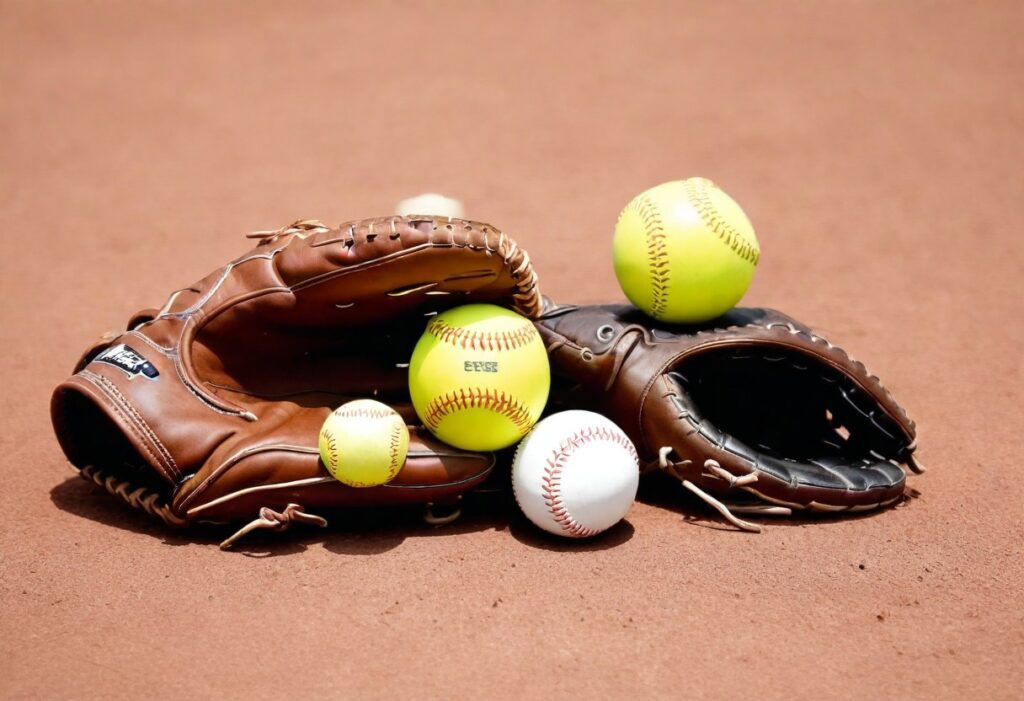
Quick Release: The Importance of Pocket Design
The design of a glove’s pocket is crucial for players who need to execute swift transitions from catching to throwing.
Open webbing, with its loose cross patterns, enhances visibility and flexibility, which is essential for fielders aiming for a quick release.
This type of webbing allows for faster ball transfers, a vital component in making those game-changing plays.
For younger players, the focus should be on a glove that offers a comfortable fit and ease of use.
Rawlings’ Sure-Catch technology exemplifies this, as it enables players to close the glove effortlessly, promoting a quicker grasp of the ball.
As players advance and the game becomes more competitive, the intricate details of pocket design and webbing become increasingly significant.
Choosing a glove that you connect with is important, but it’s also essential to remember that your first glove won’t be your last. As your skills and preferences evolve, so too can your equipment.
The table below summarizes the key aspects of pocket design for quick release:
| Feature | Benefit |
|---|---|
| Open Webbing | Increased visibility and flexibility |
| Sure-Catch Technology | Easy glove closure for beginners |
| All-Leather Shell | Durable and maintains shape |
Ultimately, whether you’re a novice or a seasoned player, the right pocket design can significantly impact your ability to make those split-second plays that define the game.
Catching Confidence: Glove Size and Fielding Success
The size of a glove is a critical factor in fielding success, particularly in softball where the ball is larger and the game’s pace is swift.
A well-fitting softball glove is larger, designed to accommodate the size of the ball, ensuring that players can make secure catches and react quickly to plays.
Baseball gloves, being smaller, allow for wrist straps for a tighter fit and greater control for handling the smaller baseball.
In the context of softball, the glove’s size is not just about the fit; it’s about the functionality. With smaller fields and faster gameplay, players must be able to transition swiftly from catching to throwing.
A glove that is too small can hinder performance, leading to missed catches or slow transitions. Conversely, a glove that is too large can be cumbersome, affecting grip and control.
Choosing the right glove size is essential for players at all levels. For younger players, the focus should be on a comfortable fit that allows for skill development.
As players advance, the precise size and design of the glove become increasingly important to meet the strategic demands of the game.
Transitioning from Catch to Throw: Glove Flexibility and Support
The transition from catching to throwing is a critical moment in both baseball and softball.
Glove flexibility and support are paramount in ensuring a smooth and rapid transfer of the ball from the glove to the throwing hand.
Open webbing designs, with their loose cross patterns, are often favored by fielders for this very reason; they offer increased visibility and flexibility which are essential during quick plays.
When selecting a glove, it’s important to consider the balance between flexibility and support.
A glove that’s too stiff may hinder quick transfers, while one that’s too flexible may not provide the necessary support for a secure catch.
Here’s a quick guide to help you understand the balance:
- Durable and Lightweight: Look for gloves that offer a good balance of durability and lightness, which aids in quicker movements.
- Sure-Catch Technology: Some gloves come with features like Rawlings’ Sure-Catch technology, which can help players close the glove more easily and securely.
Remember, the perfect glove for you is one that not only fits well but also complements your style of play. As you grow and your skills develop, your glove preferences may evolve.
Always be open to adjusting your choice to match your needs as you advance in the sport.
The Player’s Perspective: Personal Stories of Glove Selection
Pro Insights: What the Experts Prefer
Professional baseball players also often have a keen eye for the subtleties in glove design that can impact their performance.
Baseball gloves are generally a little smaller in length, tailored to the size of the baseball itself. This nuanced understanding of equipment specifications is what sets the pros apart.
Experts in the field have shared their preferences, emphasizing the importance of a glove that complements their play style.
For instance, infielders may opt for a shallower pocket to facilitate quick transfers, while outfielders might prefer a deeper pocket for better catch security.
Here’s a quick rundown of what some professional players consider when selecting their gloves:
- The snugness of the fit for better control
- The quality of the leather for durability
- The flexibility of the glove for ease of movement
- The weight of the glove for comfort during extended play
Amateur Anecdotes: Learning from Experience
The journey of selecting the perfect glove is often paved with trial and error, especially for amateur players.
Personal stories from these players reveal the nuances of finding a glove that feels like an extension of the hand.
Many recount the initial struggle to differentiate between regulation baseballs and softball gloves, noting the subtle yet significant distinctions.
One such difference highlighted in amateur circles is the main difference in the size of the catcher’s mitts.
For instance, while baseball catcher’s mitts are designed for the smaller, harder ball, softball catcher’s mitts are tailored to accommodate the sport’s larger ball.
This is reflected in the circumference of the gloves, with softball catcher’s mitts typically being slightly longer and larger.
Youth and Growth: Adapting Glove Choices Over Time
As young players embark on their baseball or softball journey, the primary focus should be on finding a glove that fits well and ensures comfort.
The intricacies of glove design become increasingly significant as players develop their skills and engage in more competitive play.
For those just starting, it’s advisable to select a glove that not only aids in learning the game but also enhances the enjoyment of the sport.
It’s essential to remember that a player’s first glove is not their last; preferences and requirements will evolve as they grow and their playing style changes.
Parents and new players often find themselves perplexed by the vast array of gloves available.
The key is to simplify the process by focusing on a few core attributes that cater to the needs of growing athletes:
- Durable and Lightweight: Opt for gloves with an all-leather shell and padded finger linings for balance, quickness, and comfort.
- Sure-Catch Technology: Features like Rawlings’ Sure-Catch technology can help young players close their gloves more easily and confidently.
Ultimately, the right glove can instill confidence, elevate a player’s game, and most importantly, make the experience enjoyable.
Read Also: Can You Put a Baseball Glove in the Dryer
Conclusion
In conclusion, baseball and softball gloves are very different. Baseball gloves are smaller and fit tightly. This helps players catch fastpitch softball gloves and throw the small baseball better.
Softball gloves are bigger with deep pockets. The bigger pocket size helps players catch and hold the larger softball. Whether you are just starting out or getting back into the sport, having the right glove for baseball or softball is important.
The perfect glove can make you better at the game. It allows you to make great plays and have more fun while playing baseball. Your glove is like a partner that helps you perform your best on the field.
Frequently Asked Questions
What are the main differences between baseball and softball gloves?
The main differences are size and pocket depth. Baseball gloves are smaller with shallower pockets for quick ball retrieval, while softball gloves are larger with deeper pockets to secure the bigger softball.
Why do softball gloves have deeper pockets?
Softball gloves have deeper pockets to accommodate the larger size of a softball, ensuring a secure catch and minimizing the chance of the ball popping out.
Can I use a baseball glove to play softball or vice versa?
While it’s possible to use a baseball glove for softball and vice versa, it’s not recommended as each type of glove is specifically designed for the size and dynamics of the respective ball.
How does the size of the glove affect gameplay?
The size of the glove can influence fielding performance. A properly sized glove can lead to better control, quicker releases, and more confident catches, which are crucial for gameplay success.
What should I look for in a glove in terms of materials and design?
Look for high-quality leather grades for durability, appropriate webbing structure for your position, and sturdy stitching. The design should provide a comfortable fit and support your playing style.
How can I ensure my glove lasts for multiple seasons?
Regular maintenance, including cleaning, conditioning, and proper storage, will help prolong the life of your glove. It’s also important to break it in correctly and repair any damage promptly.

